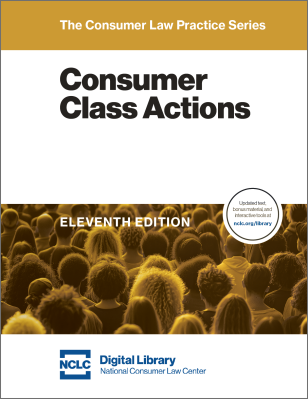As of December 1, 2018, significant amendments go into effect for Federal Rule of Civil Procedure 23, changing a number of areas of class action practice. As described below, the affected areas include class notices, class settlements, and objections to class settlements. For more detail, see the just-updated digital version of NCLC’s Consumer Class Actions. The amended rule and its accompanying 2018 Advisory Committee Note are reprinted at that treatise’s Appendix A.
Green Light for Electronic Class Notices
For the first time, Rule 23(c)(2)(B) is amended to specifically mention electronic notice. The old rule requires “the best notice that is practicable under the circumstances, including individual notice to all members who can be identified through reasonable effort.” The new rule adds the following: “The notice may be by one or more of the following: United States mail, electronic means, or other appropriate means.” The amended rule does not mandate the use of any one means of notice, but relies on courts and counsel to focus on the mean or combination of means most likely to be effective in the case before the court. Courts should exercise their discretion to select appropriate means of giving notice and should consider the capacity and limits of current technology, including a class member’s likely access to such technology. The Advisory Committee Note specifies “simply assuming that the ‘traditional’ methods are best may disregard contemporary communication realities” and miss “other means of communication that may sometimes provide a reliable additional or alternative method for giving notice.” For example, electronic notice might be the most appropriate for those who already have requested paperless billing or notices from the defendant. On the other hand, the Advisory Committee Note recognizes that “[a]lthough it may sometimes be true that electronic methods of notice, for example email, are the most promising, it is important to keep in mind that a significant portion of class members in certain cases may have limited or no access to email or the Internet.” Practitioners should thus in appropriate cases consider electronic notice either supplementing or replacing U.S. mail notice when it is practicable and useful. Possibilities include social media, email, and online advertising like websites, as well as banner and keyword searches. If using electronic notice, class counsel should be familiar with the many social media platforms (Facebook, Twitter, YouTube) and ensure the notice will work across different devices—for example, problems can arise where due to the small size and limited function of smartphones, recipients may be quicker to dismiss notices received on smartphones as opposed to their laptops. Class counsel should also become familiar with online metrics (for example, read rate, open rate, ignore rate), so as to accomplish the most efficient and effective notice plan. And class counsel should be prepared to defend their methodology. Ultimately the goal of giving notice is to enable class members to make informed decisions about whether to opt out, or—in instances where a proposed settlement is involved—to offer an objection or to make claims. Rule 23(c)(2)(B) directs that the notice be “in plain, easily understood language.” Means, format, and content should be appropriate for class members in the case. The Advisory Committee Note suggests that it may be wise to retain a class-notice expert competent in statistical analysis, to design and justify the most appropriate form of notice. The Advisory Committee Note also recommends that attention should focus on the method for opting out provided in the notice. The proposed method should be as convenient as possible, while protecting against unauthorized opt-out notices. In addition, a new amendment to Rule 23(f) makes it explicit that a court’s approval of notice to the class of a proposed settlement under Rule 23(e)(1) is not immediately appealable under Rule 23(f). New Rule 23(c)(2)(B) is discussed at NCLC’s Consumer Class Actions § 13.1.2. Electronic notice is examined in more detail at § 13.6. For either mail or electronic notice, content requirements are detailed at § 13.3, and form and style requirements are considered at § 13.4.Details of Proposed Settlement Now Required Prior to Class Notice Approval
The prevailing best practice has been to give a court as much information as possible about a proposed settlement before spending time and resources on notifying the class of a settlement that the court may only later reject. However, some class counsel are reluctant to disclose too much information about the proposed settlement at the preliminary stages of a settlement for fear of alerting potential professional objectors. The amended rule now makes it clear that courts should require detailed information about a proposed class settlement prior to approving the issuance of notice to the class. New changes to Rule 23(e)(1)(A) codify the best practice. “The parties must provide the court with information sufficient to enable it to determine whether to give notice of the proposal to the class.” The amended rule also specifies the standard a court should use in deciding whether to send the notice—that it have information such that it is likely the court will be able both to approve the settlement proposal under Rule 23(e)(2) and, if it has not previously certified the class, to certify the class for purposes of judgment on the proposal. The Advisory Committee Note suggests the type of information that might be appropriate to provide to the court when seeking permission to issue a class settlement notice including:- The extent and type of benefits that the settlement will confer on the class including, if appropriate given the nature of the proposed relief, a showing as to the contemplated claims process and the anticipated rate of claims by the class.
- The disposition of any unclaimed funds.
- The likely range of litigated outcomes, and the risks that may attend full litigation.
- The extent of discovery in the action or parallel actions.
- Other pending or anticipated litigation on behalf of the same class members involving claims that would be released under the settlement proposal.
- The proposed handling of attorney fees, whether as a specified amount or as an amount that will be deferred until the claims rate and results are determined.
- Any agreement made in connection with the proposed settlement.
For the First Time, New Rule 23 Specifies Core Standards for Court Approval of Settlements
Until the new rule changes, each circuit had established its own standards for court approval of a class settlement. For example, the Second and Third Circuits laid out a number of factors to consider, while the First Circuit gave the trial court discretion without a list of mandatory factors. This lack of uniformity led to concerns that decisions on class settlement approvals could lead to inconsistent results depending on the jurisdiction in which the case was pending. Amended Rule 23(e)(2) now requires that a court may approve a proposed class action settlement “only after a hearing and only on finding that it is fair, reasonable, and adequate after considering whether”:- 1. The class representatives and class counsel have adequately represented the class;
- 2. The settlement proposal was negotiated at arm’s length;
- 3. The class relief is adequate, taking into account:
- The costs, risks, and delay of trial and appeal;
- The effectiveness of distributing relief to the class;
- The terms of any proposed award of attorney fees, including timing of payment;
- Any agreement made in connection with the proposal which must be identified; and
- 4. The agreement treats class members equitably relative to each other.


